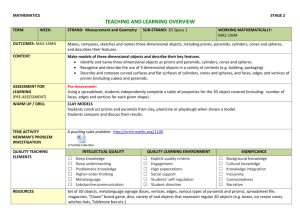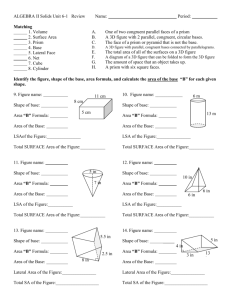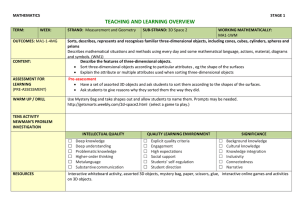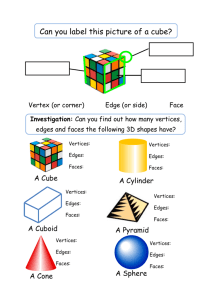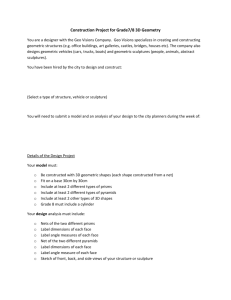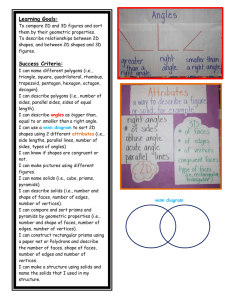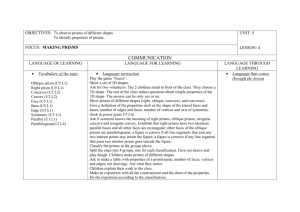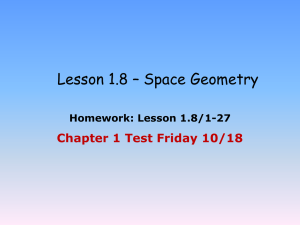3D Shapes: Teaching & Learning Overview - Stage 3 Math
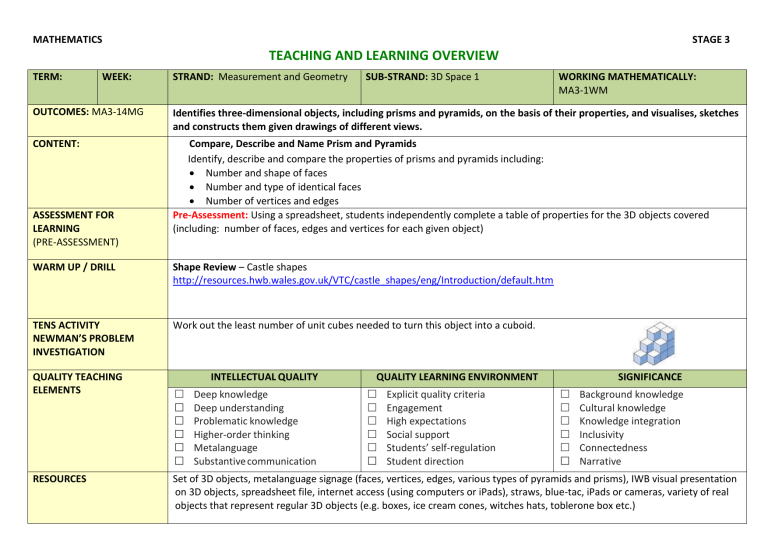
MATHEMATICS
TERM: WEEK:
OUTCOMES: MA3-14MG
CONTENT:
ASSESSMENT FOR
LEARNING
(PRE-ASSESSMENT)
WARM UP / DRILL
STAGE 3
TEACHING AND LEARNING OVERVIEW
STRAND: Measurement and Geometry SUB-STRAND: 3D Space 1 WORKING MATHEMATICALLY:
MA3-1WM
Identifies three-dimensional objects, including prisms and pyramids, on the basis of their properties, and visualises, sketches and constructs them given drawings of different views.
Compare, Describe and Name Prism and Pyramids
Identify, describe and compare the properties of prisms and pyramids including:
Number and shape of faces
Number and type of identical faces
Number of vertices and edges
Pre-Assessment: Using a spreadsheet, students independently complete a table of properties for the 3D objects covered
(including: number of faces, edges and vertices for each given object)
TENS ACTIVITY
NEWMAN’S PROBLEM
INVESTIGATION
QUALITY TEACHING
ELEMENTS
Shape Review – Castle shapes http://resources.hwb.wales.gov.uk/VTC/castle_shapes/eng/Introduction/default.htm
Work out the least number of unit cubes needed to turn this object into a cuboid.
RESOURCES
INTELLECTUAL QUALITY
Deep knowledge
Deep understanding
Problematic knowledge
Higher-order thinking
Metalanguage
Substantive communication
QUALITY LEARNING ENVIRONMENT
Explicit quality criteria
Engagement
High expectations
Social support
Students’ self-regulation
Student direction
SIGNIFICANCE
Background knowledge
Cultural knowledge
Knowledge integration
Inclusivity
Connectedness
Narrative
Set of 3D objects, metalanguage signage (faces, vertices, edges, various types of pyramids and prisms), IWB visual presentation on 3D objects, spreadsheet file, internet access (using computers or iPads), straws, blue-tac, iPads or cameras, variety of real objects that represent regular 3D objects (e.g. boxes, ice cream cones, witches hats, toblerone box etc.)
TEACHING AND LEARNING EXPERIENCES
GUIDED & INDEPENDENT ACTIVITIES WHOLE CLASS INSTRUCTION
MODELLED ACTIVITIES
Explicitly communicate lesson outcomes and work quality.
Define and reinforce
metalanguage in the unit: e.g. pyramid, prism, face, edge, vertex, vertices, triangular prism, square prism, cube, rectangular prism, pentagonal prism, triangular pyramid, square pyramid, rectangular pyramid, cross-section, surface, curved, flat and perspective Also include regular 2D shapes. (square, triangle, rectangle, pentagon, hexagon and octagon)
Teach and review the names of regular three dimensional objects and review the terms faces, edges and vertices.
Three-Dimensional Viewpoints
In groups, students are given a
3D object. They are asked to identify as many attributes as they can in 3 minutes. Share with the group and discuss any additional attributes identified.
Make a 3D object “wall” identify each object and its attributes.
LEARNING
SEQUENCE
Remediation
S2 or Early S3
LEARNING
SEQUENCE
S3
LEARNING
SEQUENCE
Extension
Early S4
EVALUATION &
REFLECTION
3D object – match object to label http://www.math-play.com/3d-shapes-game/3d-shapesconcentration.html
Review properties of 3d objects http://www.bgfl.org/bgfl/custom/resources_ftp/client_ftp/ks2/maths/3d/index.htm
Investigate the properties of 3D objects using: http://www.bgfl.org/bgfl/custom/resources_ftp/client_ftp/ks2/maths/3d/index.htm
Construct a 3D model, given a set number of straws and blue tac. Students photograph their object and describe their properties (faces, edges and vertices). Vary the number of straws given.
Who Am I? In pairs, students are given a 3D object and make up “Who Am I” clues using appropriate terminology. Place the object in a bag then share with another group or the class. Who can guess the correct object?
Investigation: Sketch a variety of everyday objects (eg: buildings). Sketch from the front, top and side. Recreate these objects using clay and cut to identify the cross sections.
Assessment: Ask students to:
Look at a drawing/photograph and make a reasonable model of the object using various materials and draw different viewpoints of a given object
Create as many prisms as possible given a number of interconnecting cubes.
Student Engagement:
Resources:
Achievement of Outcomes:
Follow Up:
